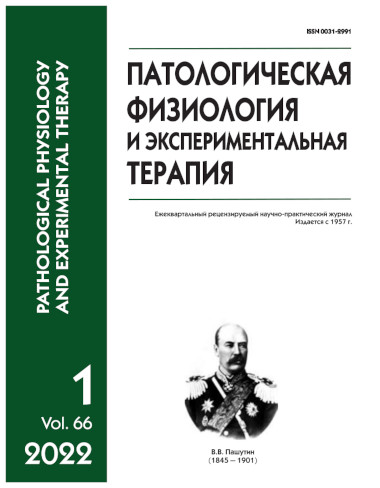Molecular mechanisms controlling the severity of hemorrhage after inhibition of TхA2 synthesis in platelets
Abstract
The aim of the study was to establish the pathogenetic and compensatory mechanisms involved in maintaining and limiting hematuria when prescribing high-dose NSAIDs in patients with nephrolithiasis. Methods. The study included 21 patients with nephrolithiasis, in whom high doses of NSAIDs were prescribed for analgesia for 9 days. The severity of hematuria and leukocyturia was assessed at the time of hospitalization, and at 24 hrs, and 48 hrs after ureterolithotripsy (ULT) in the upper ureter. The study used receptor agonists involved in the modulation of thrombogenesis, in particular, ADP, ATP, angiotensin II, adrenaline, type IV collagen, platelet activating factor (PAF), adenosine, and isoprenaline. Agonists were used at a concentration of EC50 and EC10. The analysis of the functional activity of the receptors was performed by the turbidimetric method on a ChronoLog analyzer (USA). The analysis of the aggregates was performed according to the following parameters: the amplitude of platelet aggregation; maximum slope of the curve (Slope); area under the curve (AUC). Statistical analysis was performed using the MedCalc package. Results. When NSAIDs were prescribed, the incidence of gross hematuria persisted for 48 hrs after URT; the severity of microhematuria decreased (p < 0.001) compared to the level 24 hrs after minimally invasive surgery. Leukocyturia decreased (p < 0.001) 24 hrs and 48 hrs after ULT. Hematuria persisted in the presence of α2-adrenoceptor hyperreactivity and of PAF receptor and purine P2X1 receptor normoreactivity. When comparing the parameters of the aggregation curves, it was found that the maximum effect of platelet aggregation was observed during the interaction of the α2-adrenoceptor and the P2X1 receptor. A less significant synergistic effect was evident with simultaneous stimulation of the α2-adrenoceptor and PAF receptor, as well as the P2X1 receptor and the PAF receptor. Conclusion. Analysis of the functional activity of platelet receptors after ULT with high doses of NSAIDs indicates that the activation of the sympathoadrenal system is a trigger of a compensatory response aimed at limiting hematuria. The effectiveness of the compensatory reaction of hemostasis is enhanced as a result of the potentiation of the pro-aggregant effects of the α2-adrenoceptor, the P2X1 receptor, and the PAF receptor.






